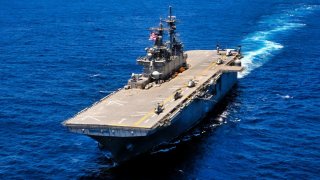The U.S. Navy’s Logistical Challenges: A Threat to Naval Dominance?
Imperial Japanese prime minister Hideki Tōjō credited U.S. Navy underway replenishment as a central cause of American victory in World War II. He was right. Let us resolve never again to slight the importance of ferrying beans, bullets, and black oil to the fighting forces. The principle of continuity demands it.
The late Professor Michael Handel codified the “principle of continuity,” rebranding the Prussian soldier-scribe Carl von Clausewitz’s dictum that to win decisively on the battlefield, a field commander should land “blow after blow” against the enemy “in the same direction,” striking repeatedly “with all his strength.” Bucking that principle—failing to hammer away without surcease—grants the foe a respite to recover from a tactical defeat while attenuating the average magnitude of combat power aimed at it over time. In short, intermittent or desultory operations enfeeble the war effort.
And court defeat.
The U.S. Navy has been breaching the principle of continuity for decades, and to its own peril. At present, for example, surface combatants—guided-missile destroyers and cruisers—have to withdraw from a battle zone when they exhaust their missile inventories. They have to steam back to a specially equipped port to rearm. The logistics fleet cannot rearm them at sea for fear of damaging munitions or vertical launchers as the recipient and delivery ships sway with the waves. Depending on where the theater of conflict lies, the simple feat of rearming could mean voyaging thousands of miles—perhaps even all the way to a U.S. seaport. Such a journey would deduct whatever fraction that ship contributes to the fleet’s overall fighting strength—96 vertical launch siloes’ worth of missiles in the case of a destroyer, the surface navy’s workhorse—for weeks at a time.
So much for exerting yourself to the utmost. Handel and Clausewitz frown.
Moreover, it is common practice for combat logistics vessels to withdraw from fleet operations and put into port to restock with fuel, ammunition, and stores for delivery to the fleet. Doing so imperils these precious assets during transit—they would be my prime target if you gave me command of China’s or Russia’s armed forces—while capping the amount of support they provide. Clausewitz says little about logistics in his masterwork On War. But as a veteran of decades of war against Revolutionary and Napoleonic France, he knew well that logistics is an indispensable enabler for everything a military force does. Commanders cannot rain blow after blow against an antagonist without sustenance from the supply train.
Victory could elude the U.S. Navy because of logistical neglect.
This is a pretty stinging indictment, I know. But don’t take it from me. Take it from Navy Secretary Carlos Del Toro, who has made rectifying the sea service’s logistical woes his mission. Last week Secretary Del Toro addressed the Naval War College’s Future Warfighting Symposium, an event that heralds the beginning of each academic year. In the course of his remarks he announced that marine engineers are poised to field two new technologies to keep more of the fleet on the firing line in wartime.
First, the Naval Surface Warfare Center recently completed the first test of the Transportable Rearming Mechanism, or TRAM. This test took place on land. Del Toro has directed the service to test TRAM at sea this fall. If field trials pan out, and once the system has been mass-produced and installed aboard ammunition ships, the surface navy will have its first capability to reload vertical launchers while riding the open sea. Ships of war will be able to remain on station in fighting trim.
And the U.S. Navy will have drawn nearer to meeting Handel’s and Clausewitz’s continuity standard.
Second, Del Toro reported that the Modular CONSOL Adapter Kit, or MCAK, will be fielded this week. The kit can be mounted aboard commercial ships within 36 hours to refuel navy tankers—obviating the need for them to depart the fleet to replenish. Merchantmen will refuel naval logistics ships, which will then refuel warships. In effect MCAK will boost the size of the U.S. Navy supply train without adding new purpose-built ships. And the battle fleet’s staying power on the scene will increase.
Imperial Japanese prime minister Hideki Tōjō credited U.S. Navy underway replenishment as a central cause of American victory in World War II. He was right. Let us resolve never again to slight the importance of ferrying beans, bullets, and black oil to the fighting forces. The principle of continuity demands it.
About the Author: Dr. James Holmes
Dr. James Holmes is J. C. Wylie Chair of Maritime Strategy at the Naval War College and a Distinguished Fellow at the Brute Krulak Center for Innovation & Future Warfare, Marine Corps University. The views voiced here are his alone.
Image Credit: Creative Commoms.


